The Wilcox Train Robbery
This post is a part of our series on Tom Horn – full collection of links at the bottom of the page.
Tom Horn was discharged from civilian service in the army (he had served with distinction in the Spanish-American War) in the early fall of 1898. A period of recuperation from the “Cuban fever” no doubt followed.
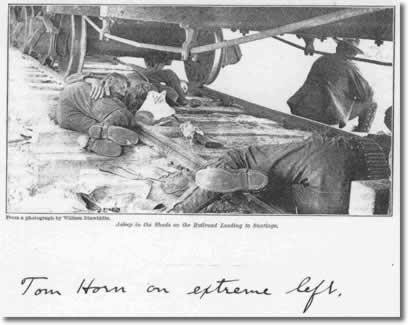
As he healed, in the meantime he developed an interest in a major event to the extent that he was used as an investigator. It was the Wilcox train robbery of June 2, 1899.
At the time of the robbery, the Union Pacific Rail Road’s tracks ran north and east of present-day Rock River, Wyoming. (In 1900 the railroad embarked on a track-shortening project that moved the line to its present location. The location of the robbery today is on privately owned land.)
It was known that the railroad moved large shipments of currency, gold and silver, and other valuables on specific trains, the identity of which were supposedly well guarded secrets. However, information leaked out that high-value cargo, including unsigned bank notes and silver would leave the UP’s headquarters at Omaha to points west. One theory was that “Elzy” Lay, one of Butch Cassidy’s associates, arrived in Medicine Bow the day before the 2:00 a.m. robbery with word for his confederates that the evening train would be carrying loot in the express car.
Three robbers (some accounts, not well verified, pointed to six men) stopped the train just east of a bridge on the rainy morning of June 2. After uncoupling the passenger cars behind the locomotive, tender, mail car and express car, they ordered Engineer Jones to pull past the bridge for a moment. They then dynamited the bridge with charges they had already put in place in order to block the second section of the train from following them.
The train pulled ahead about two miles. They first ordered the mail car opened, after which they learned that any valuables on board were in the locked express car. When the expressman, Charles T. Woodcock, refused to open the express car, they blasted the door open. Woodcock was dazed from the explosion, and either could not remember the combination to the safe or pretended he could not. At that the robbers blew the safe, using such an excessive amount of the “giant powder” that the entire car was destroyed. They escaped on horses they had hidden nearby with over $50,000 in loot.
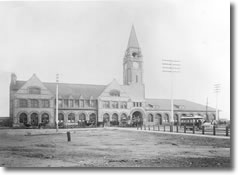
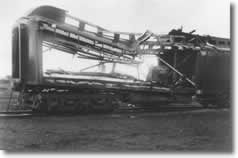
They headed north toward Casper, secretly crossed the North Platte River and continued north toward the Big Horn Mountains. Stopping to rest overnight, they killed Douglas Sheriff Josiah Hazen when his posse discovered their horses and where they were. In the shootout that followed, they escaped on foot and reached the Big Horns. There they acquired fresh horses from “Black Billy” Hill, a local rancher known to be sympathetic to rustlers and others of their ilk.
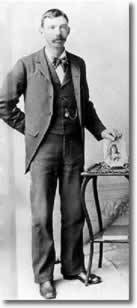
Another posse, that included railroad officials, U.S. Marshal Frank A. Hadsell and others followed the robbers but lost them west of the Big Horns and south of Thermopolis. Investigations by subsequent groups failed to learn who the robbers were and where they headed.
It has been learned that Tom Horn quietly investigated the robbery. He may have been working in some capacity for the Pinkertons as well as the UPRR simply because of the agency’s relationship with the railroad.
Joe LeFors, who later plotted Tom Horn’s downfall, was a member of the Wilcox posse, and was himself a Pinkerton operative with the cipher (code name) of “Pulet.” Other prominent figures in turn-of-the-century annals who were Pinkerton operatives were assigned various ciphers. A few were Frank A. Hadsell, U.S. Marshal, who was assigned “Log;” Peter Swanson, Rock Springs sheriff, was “Stone;” Creede McDaniels, sheriff in Rawlins, was “Hamper;” Thomas Horton, also a sheriff in Rawlins, was “Muff;” R. D. Meldrum, deputy sheriff in Dixon, was “Cigar;” and Charles Ayres, stock association inspector, Dixon, was “Stamp.” There is no record of Horn’s cipher.
At some time after the robbery Horn embarked on his investigation. He generated a report to the division superintendent of the Union Pacific in Cheyenne on the identity of the three robbers who had headed north from Wilcox into the Big Horn Mountains:
“I told him that he had some information that I wanted and he must give it to me,
or I would kill him and be done with him.”
Iron Mountain, Wyo.
January 15th, 1900
E. C. Harris, Esq.
Cheyenne, Wyo.
I have this to report in regard to my investigation in Johnson County:
On January second I went to the house of old Bill Speck, and stayed all night with him. In the morning it was snowing and I stayed all day.
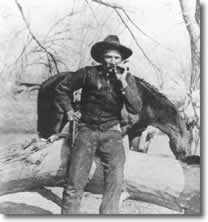
Occasionally I would bring up the train robbery, and he never wanted to talk about it, so on the morning of the fourth when I was going to leave I told him that he had some information that I wanted and he must give it to me, or I would kill him and be done with him. Well, that was just Speck was looking for, and he commenced to cry and said the rest of the rustlers would kill him if he told. I told him I was worse than they, because I would surely kill then and there if he did not tell me, as no man was within eight miles of us.
“he could blow Christ off the Cross with dynamite”
Speck asked my protection from the rest of the rustlers, which of course I offered him, and then he told me as follows:
The morning of the killing of Joe Hazen, George Currie came to Billy Hill’s ranch on Red Fork of Powder River about one o’clock in the morning, and wanted to get some of his own horses that were at Hill’s ranch in charge of Alec Ghent. Currie had four horses there, but there were only two of them in the pasture, the rest being out on the range. Ghent had been looking for these other two horses for three weeks, but could not find them. Currie got his own two horses, and Hill gave him two. Currie told Hill, Speck and Ghent of the robbery, and said it was himself, Harve Ray and a stranger in Powder River country [who had committed it], but Currie would not give his name, saying only that the stranger came from the British possessions and that he could blow Christ off the Cross with dynamite….
This essay was originally published on Chip Carlson’s personal website, which has since expired, and is re-published here as a way to preserve some of the content of this historical figure. If you would like to continue learning about Tom Horn, please explore the links below. If you’d like to read the complete story, and help to support the author, his book can be purchased here.
More about Tom Horn:
Tom Horn (main page)
The Tom Horn Story (summary)
